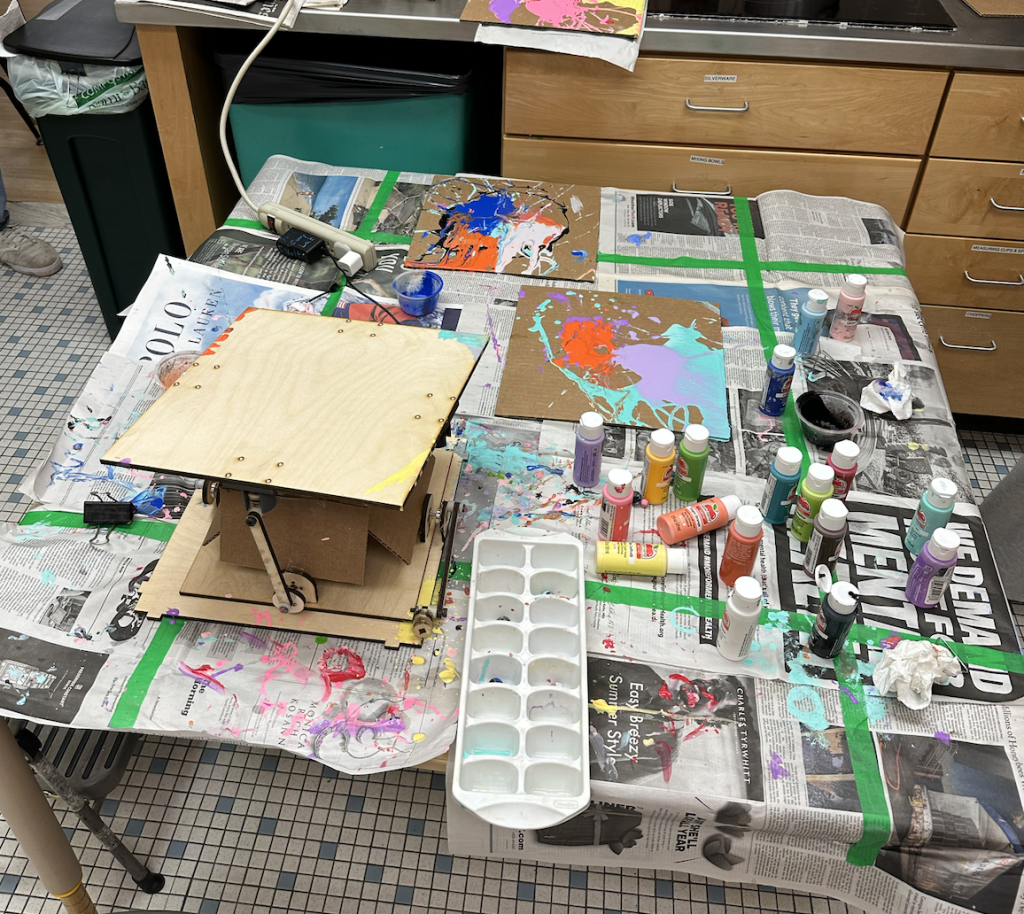Primary Observations
The children were able to actively interact with our project. There are some steps that are required to build up towards the moment of discovery for the children. We had to tell them the steps to get our project set up for them. Once they started to play with the marbles, the children found different ways to interact with the paint as well. We observed some children wanting to mix multiple colors of paint to color the canvas where some kids wanted to push the marble with their hands while it was on the canvas.
The pieces that the children created were really amazing but there was some difference between the preschoolers (3~4 year olds) and the kindergarten group. The older children were able to interact with the marble more in different ways causing the paintings to be more dynamic and have more lines and streaks.
Originally, we expected to have marble runs where the children would pour the paint and marbles onto the canvas. However, having the children pour their own paint and directly interact with the marbles allowed us to have more unique pieces. So we decided that we would keep the marble runs only to help the children drop the marbles onto the canvas. The children would ultimately pour the paint themselves and would drop the marbles using their hand or the marble runs.



Technical Limitations
Our project ended up working right before the visit so there were some parts that were unaccounted for. We had to make sure that the electronics in the middle were covered so paint could not get on them as well as making sure the motors kept on moving even with child interaction. The children were naturally curious about the cranks and moving joints so they were touching the parts. This led to the pistons attached to the crank falling out sometimes. During the first couples of groups, the cranks held up just fine, but towards the end of the visit, the pistons fell out more often.
Another technical limitation we observed was the movement of the canvas. This was somewhat expected since the canvas is not balanced and tuned percisely, but the tilt motion would not create a perfect spiral motion for the marble. This also led to the marble not staying on the canvas long enough and the children had to use many marbles to satisfied.


Second Prototype Goals
We would say that our prototype was a success and there definitely were points where the children were captivated and engaging with the project actively. However, for the second iteration we want to refine these points of captivation. Specifically with the canvas motion and tuning the parts and code so that the spiral motion is more consistent. Refining this motion will also allow for the pistons to become more stable and fall out less often. There are some limitation since we know we can produce every single part precisely and it hard to balance the canvas perfectly but these limitations can be somewhat accounted for through software calibration.
As you can see in the first video of Preschoolers dropping marbles on to the canvas, they grab the canvas and try to make the marble stay on the canvas. In order to let them watch the marble move around more, we are thinking of creating a low barrier (clear acrylic) around the canvas that has an exit on each side. By making a barrier, the marble can make more diverse strokes of paint that kids can enjoy watching.
We also need to create the marble run that the children will drop their marbles into. These will most likely be made out of wood and produce motions that can create additional different strokes on the canvas.
We are still planning on putting containers filled with water where marbles can fall into. They will be located right under the barrier marble exits. This way, the kids can wash the marbles themselves. In order to prevent water and paint from splashing on the electronics, we can make a clear acrylic shield behind the cranks so that kids can still see what’s moving the canvas.
Leave a Reply
You must be logged in to post a comment.